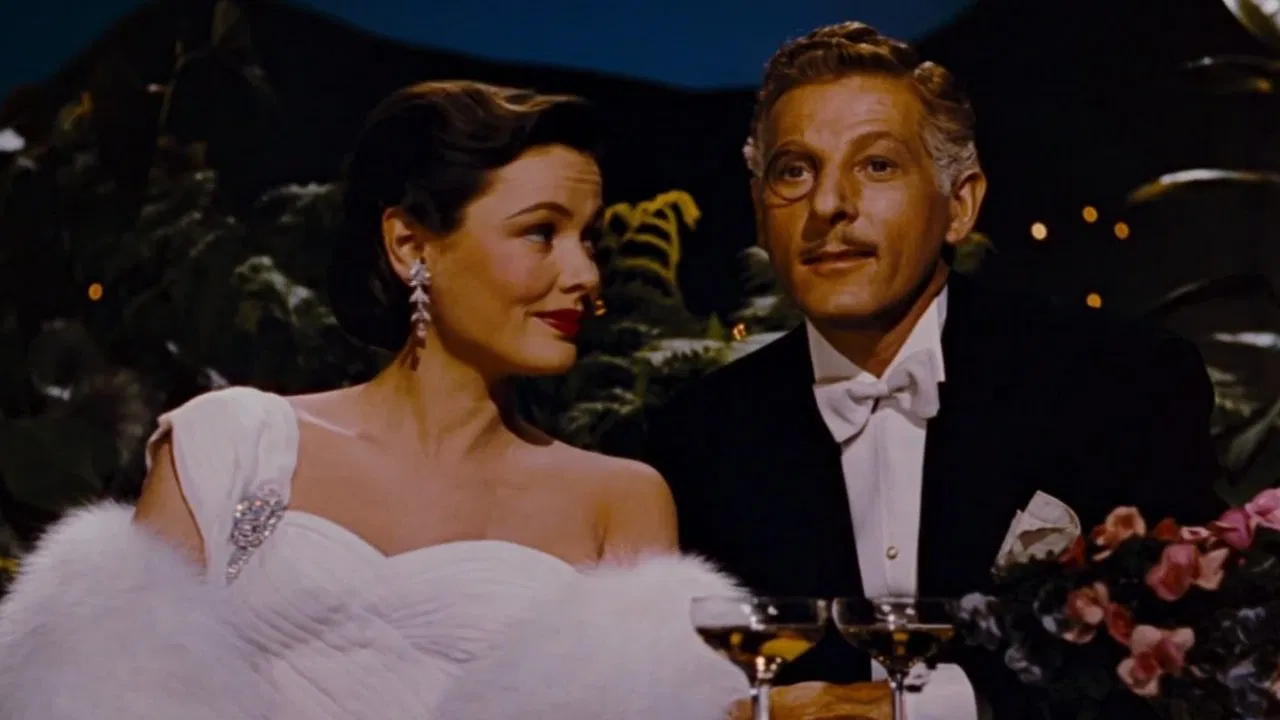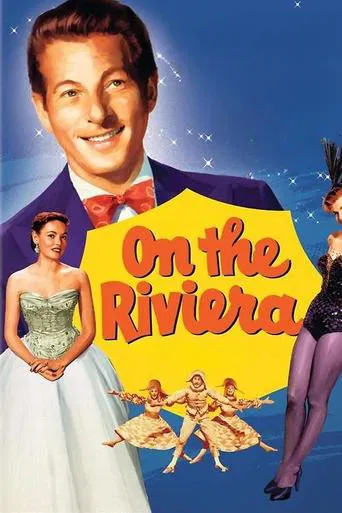

Good story, Not enough for a whole film
... View Moreit is the rare 'crazy' movie that actually has something to say.
... View MoreThe tone of this movie is interesting -- the stakes are both dramatic and high, but it's balanced with a lot of fun, tongue and cheek dialogue.
... View MoreAll of these films share one commonality, that being a kind of emotional center that humanizes a cast of monsters.
... View MoreOn the Riviera is the third film made from a stage play called The Red Cat, the other two being L'homme des Folies Bergère (1935) with Maurice Chevalier and That Night in Rio (1941) with Don Ameche. The plot is an example of a genre that goes right back to Plautus and Shakespeare: the comedy and confusion that result when two people who happen to look identical keep getting mistaken for each other. In this case, the two people (both played by Danny Kaye) are a famous French transatlantic aviator and an American entertainer playing a club on the French Riviera. This seems like a very obscure film: it's not found in any of the half-dozen standard film guides I happen to have, though it's in IMDb.The film, directed by Hollywood workmanlike director Walter Lang (who made a number of other 50s musicals, like this one now mostly forgotten,) is a semi-musical; that is, there are plenty of song and dance numbers, but they are all stage performances. The most interesting aspect of the film is its display of Kaye's multiple talents as a singer, dancer, comic and impressionist -- he's the sort of performer popular in the thirties through early sixties, but now seems an almost extinct species.The film is an interesting period piece for its sumptuous female fashions and as an early example of what would become mainstream American Hollywood musical entertainment, and if you are interested in those topics, or in Kaye, this will be worth watching. Others may find it only moderately entertaining. There is some impressive landscape photography of the Riviera, though Hitchcock did this better in To Catch a Thief.The 20th Century Fox Home Entertainment Blu-Ray DVD is of good audio and video quality.
... View MoreThe third and final filming of the same basic story by Fox studios over a 16 year span. Originally conceived as two distinct films: one an impersonation farce, based on the play "The Red Cat", and the other a musical romance. Zanuck knew it would be a compelling story of perfect mimicry of a rich philandering man by a stage performer, and sometimes the opposite. I have seen the last 2 versions in full, and a 20 min. compendium of mostly the musical numbers of the first. They all have their distinctive overall personalities, especially in the stage numbers, thus warrant viewing each. The '35 version includes a number of Busby Berkeley-like kaleidoscopic productions involving a large team of chorus girls, as was the 'in thing' during that era, along with Maurice Chevalier's distinctive stage personality(which Kaye briefly imitates in the present film). The '41 version introduced Technicolor, dominated by the 3 musical-drama stars of Don Ameche, Carmen Miranda, and Alice Faye, with new songs by Harry Warren and Mack Gordon. Whereas the other two versions were sited in France, as intended, the second one was awkwardly sited in Rio(actually, a sound stage), in deference to the presence of Carmen, and the 'good neighbor policy' of FDR. In contrast to Gene Tierney's persona in the present film, as simply an elegant gorgeous 'trophy wife', Alice Faye, in Gene's role in that film, sang a romantic tune on several informal occasions. Although both beauties, they were quite different: Gene with her cool natural smiling regal demeanor vs. Alice, with her big languid soul-searching eyes.Corinne Calvert hardly had the popular visibility of her counterpart in the '41 film: Carmen Miranda. She came across as a conventional French chorus girl, who happened to be showman Martin's current girlfriend. She rather reminds me of the later Ann-Margaret, in looks and personality. My impression is that she got more screen time in the non-musical portions than did Carmen, who dominated most of the staged musical productions. Behind the camera, the film was directed by veteran Walter Lang, with veteran Sol Siegel the producer, both with quite few past and future Fox musicals to their credits. Legendary Alfred Newman was the music director, as he was in the '41 version. Danny's wife, Sylvia Fine, composed most of the music, as she apparently had for most of his career.Legendary Jack Cole was chief choreographer, as betrayed by the lavish, imaginative, sometimes exotic, exuberant stage dance routines, which provide a more than credible answer to the lavish Carmine Miranda-led dance routines in the '41 film. Jack devised the unique memorable "Popo the Puppet" production, with Danny speaking childlike, including some trademark mangled nouns(ex.: ephelant, hipponoticus), and including some supporting clown-like puppets. Certainly the highlight of the film for children, and my all time favorite Kaye performance. Jack's penchant for multileveled dance and skit productions is also evident in most of the numbers. Instead of the traditional brief reprisals of the main songs in the finale, as in the '41 version, we have a new appropriate song and exuberant dance production to end the film on. Jack's star pupil, Gwen Verdon, leads the introductory stage show. Jack would go on to be Marilyn Monroe's requested choreographer for most of her high profile films. Danny plays a famous airplane pilot and investor in new plane design manufacture. Ironically, about a decade later, he would become interested in piloting airplanes, bought several, and became a vice president of Learjet!The complicated non-musical portions apparently are considered boring by some, but not by me. Overall, they are certainly more interesting than in the '41 version. You certainly have to pay close attention not to get occasionally lost on whether you are watching Durant or Martin, and whether they are playing themselves or the other. This is complicated by the sometimes uncertainty as to whether the women are being fooled or only pretending to be. In the end, all is forgiven. Durant presumably saves his airplane business, and Martin's attention to Durant's wife made Durant realize that he should cutout his philandering and concentrate on her. Martin and Corinne also make up in the finale. All in all, I think it's a toss up whether this or the '41 version is more entertaining. This one is more dependent upon a single superstar.The current DVD release has excellent documentary extras on Danny and Jack Cole, as well as a partial comparison of the 3 versions.If you like this type of film: fusing comical impersonations by doubles with song and dance, I can also recommend a much more obscure, but fun, film from the '30s, called "Honolulu". Robert Young plays 2 look alike men: a movie idol trying to escape from suffocating celebrity, and a member of a rich Hawaiian family who also wants to escape from his limited life. Eleanor Powell provides some unique exuberant dancing, and a masquerade party heightens the theme of impersonations.
... View MoreI'm afraid I couldn't get with the program here. Danny Kaye is responsible for some of the funnier movies ever made, but this plot is a weak comedy of manners. It has Kaye as Jack Martin, a nightclub impersonator, being called on to pretend he's a celebrated, aristocratic French aviator. There is a mix up with the aviator's wife, Gene Tierney, and Kay's girl friend, Corinne Calvet, gets jealous.It's in glorious Technicolor but it's all been done elsewhere, often better, as in "The Prisoner of Zenda." Sometimes worse, as in "The Front." There's little in the way of physical comedy. Kaye doesn't take any pratfalls. He rarely seems as rattled as he does in his usual screen persona -- more embarrassed than neurotic and cowardly. He doesn't sing a gibberish song. The location needn't have been the French Riviera. Kaye's part could easily have been given to anyone else.It's as much a musical as it is a comedy. Kaye plays a showman and does his musical numbers straight. None are memorable ("Ballin' the Jack") and Kaye wears a tuxedo. Kaye is energetic enough, on stage and off stage, and his voice is pleasant, but that's about it. One of his songs' best features is that it used (unless I'm mistaken) Gwen Verdon for one of the lead dancers. She should have had more screen time.If this was an attempt to broaden the style of Kaye's performances, it really doesn't work. As a comedian, with a good script, he's superb. As a singer and dancer, he's mediocre.
... View MoreKaye won a Golden Globe for his great performance in dual roles as a military giant and an entertainer who tries to win the love of Gene Tierney. A fun filled musical comedy with great dancing and the always unstoppable Kaye, doing what he does best.
... View More